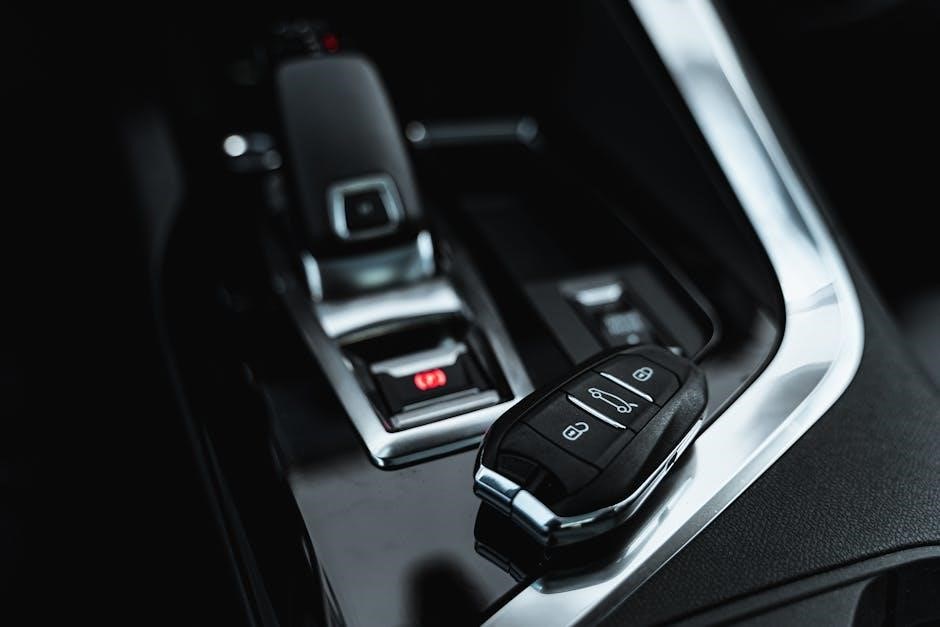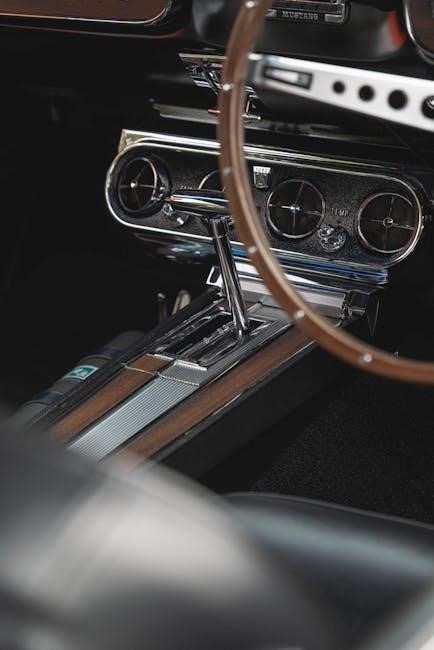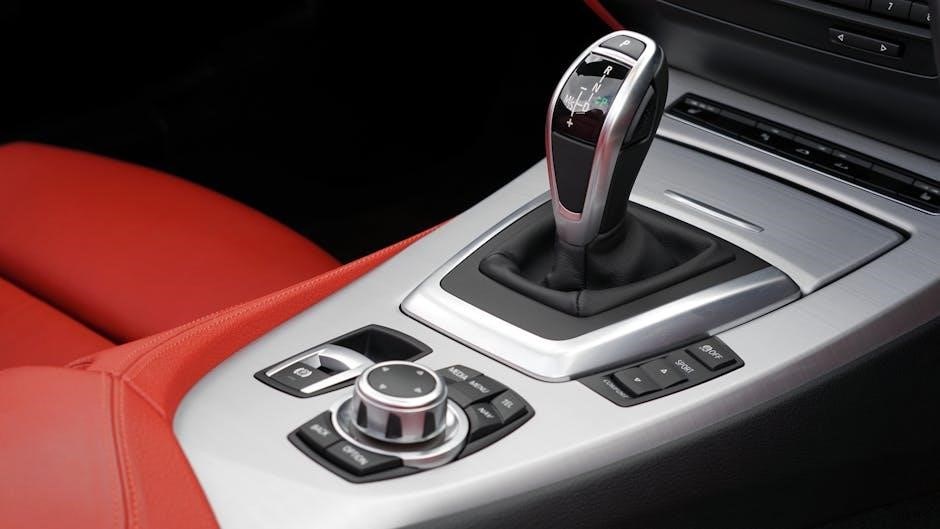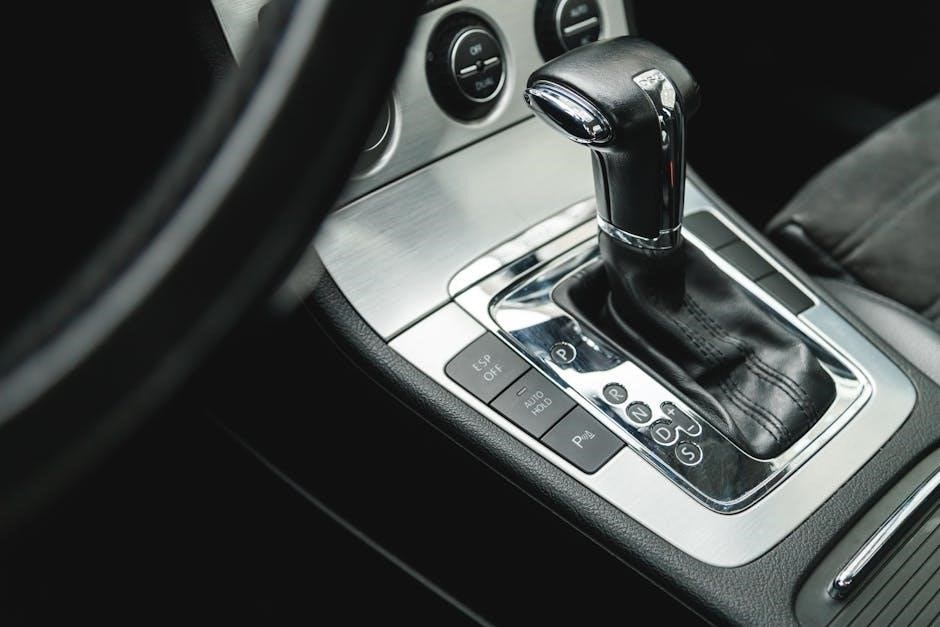A manual transmission shifter is a crucial component in vehicles, enabling drivers to control gear changes for optimal performance and fuel efficiency. Understanding its mechanics is essential for smooth operation and maintenance.
1.1 Definition and Purpose
A manual transmission shifter is a component in vehicles that allows drivers to manually change gears in a non-automatic transmission system. It consists of a gear knob, shift handle, and linkage, enabling precise control over gear selection. The shifter’s primary purpose is to engage and disengage gears smoothly, ensuring efficient power transfer from the engine to the wheels. Proper use enhances fuel efficiency, performance, and driving experience, making it a fundamental skill for drivers of manual vehicles.
1.2 Brief History and Evolution
The manual transmission shifter has evolved significantly since its invention in the late 19th century. Early systems were cumbersome, requiring complex linkages. By the mid-20th century, synchronized gearboxes became standard, reducing difficulty in shifting. Modern shifters now feature ergonomic designs, shorter throws, and precise engagement, enhancing driver comfort and performance. Advances in materials and technology continue to refine the shifter’s functionality, ensuring smoother and more efficient gear changes while maintaining the classic appeal of manual driving.

Key Components of a Manual Transmission Shifter
A manual transmission shifter consists of the gear knob, shift handle, shift rod, linkage, and mounting hardware. These parts work together to enable precise gear engagement.
2.1 Gear Knob and Shift Handle
The gear knob and shift handle are essential for controlling the transmission. The shift handle connects to the shift rod, translating driver input into gear changes. Weighted knobs improve shift feel by adding inertia, requiring more force to engage gears. This provides a more precise and controlled shifting experience. Proper design and material ensure durability and comfort, while customizable knobs can enhance aesthetics and driver preference. Regular maintenance, like checking for wear on the handle and knob, is crucial for optimal performance and longevity of the shifter assembly.
2.2 Shift Rod and Linkage
The shift rod and linkage are vital components that connect the gear knob to the transmission. They translate the driver’s movements into precise gear engagement. The shift rod transfers motion from the shifter to the gearbox, while the linkage ensures smooth, accurate gear changes. Proper alignment and lubrication are essential for optimal performance. Over time, wear on these parts can lead to loose or imprecise shifting. Regular inspections and maintenance are crucial to prevent issues like misalignment or damage, ensuring reliable and smooth gear transitions. Their durability directly impacts the overall functionality of the manual transmission system.
2.3 Mounting Hardware and Bushings
Mouting hardware and bushings are essential for securing the manual transmission shifter in place and ensuring smooth operation. These components absorb vibrations, reduce noise, and provide stability to the shifter assembly. Bushings, typically made of durable materials like rubber or polyurethane, act as cushions between moving parts, facilitating precise gear changes. Proper installation and alignment of these elements are critical to prevent misalignment or wear. Over time, bushings can degrade, leading to loose shifting or difficulty engaging gears. Regular inspections and replacements are vital to maintain optimal shifter performance and driver control.

Common Problems and Maintenance
Common issues with manual transmission shifters include difficulty shifting gears, noisy operation, and wear on components like bushings and linkages. Regular maintenance, such as lubricating moving parts and inspecting hardware, helps prevent these problems and ensures smooth operation.
3.1 Difficulty Shifting Gears
Difficulty shifting gears is a common issue with manual transmission shifters. It can arise from worn-out bushings, misaligned shift rods, or improper clutch operation. If the clutch isn’t fully disengaged, gears may not shift smoothly, leading to grinding or hesitation. Additionally, debris or lack of lubrication in the linkage can cause resistance. Drivers may also experience trouble if the gear knob or shift handle is loose or damaged. Regular inspection and maintenance of these components can prevent such issues, ensuring smooth and precise gear changes. Addressing these problems early helps avoid more severe transmission damage.
3.2 Noisy Operation
Noisy operation in manual transmission shifters can be caused by worn-out components like bushings, bearings, or the gear knob. Loose mounting hardware or misaligned shift rods may also produce clunking or rattling sounds. Over time, dirt and debris can accumulate in the linkage, leading to noisy shifting. In some cases, a lack of lubrication in the gearbox or excessive wear on the synchronizers can generate abnormal noises during gear changes. Addressing these issues promptly is crucial to prevent further damage and ensure smooth, quiet operation of the transmission system.
3.3 Wear and Tear
Wear and tear on manual transmission shifters can occur due to frequent use, improper shifting techniques, or lack of maintenance. Components like the shift rod, bushings, and gear knob may degrade over time, leading to loose connections or difficulty in engaging gears. Regular lubrication of the linkage and gearbox can help minimize friction and extend the lifespan of these parts. Inspecting and replacing worn-out components promptly is essential to maintain smooth operation; Neglecting wear and tear can lead to more severe issues, such as gear misalignment or complete shifter failure, requiring costly repairs.

How Manual Transmission Shifters Work
The manual transmission shifter operates by connecting driver input to the gearbox, enabling precise gear selection. Using the clutch pedal, drivers disengage the engine from the transmission, allowing smooth shifts between gears. The shifter’s mechanical linkage translates physical movements into gear changes, ensuring control over speed and torque. Proper synchronization and alignment are crucial for seamless operation, making the shifter an essential interface between the driver and the vehicle’s powertrain system.
4.1 Role of the Clutch Pedal
The clutch pedal plays a vital role in manual transmission operation. By pressing the pedal, the driver disengages the engine from the transmission, allowing gear shifts without grinding. When released, it reconnects the engine to the transmission. Proper clutch control ensures smooth acceleration and prevents wear on components. Drivers must find the “biting point” where the clutch begins to engage, enabling seamless transitions between gears. This skill is essential for effective manual driving, reducing wear and tear on the transmission system while maintaining vehicle control during acceleration and deceleration.
4.2 Engaging and Disengaging Gears
Engaging and disengaging gears in a manual transmission requires coordination between the clutch pedal and the shift lever. To shift gears, press the clutch pedal fully, disconnecting the engine from the transmission; Move the shifter into the desired gear, ensuring it clicks into place. Slowly release the clutch while pressing the accelerator to engage the gear smoothly. Proper timing and control prevent grinding or jerky transitions. Avoid riding the clutch, as this can wear out components. Smooth engagement enhances performance, reduces wear, and maintains control during acceleration or deceleration.
4.3 Synchronizers and Gear Engagement
Synchronizers play a vital role in smooth gear engagement by syncing the speed of the gear and the shaft. When shifting, the synchronizer ensures gears mesh properly, preventing grinding. During upshifting or downshifting, the clutch disengages the engine, allowing the synchronizer to align gear speeds. This mechanism enables seamless transitions between gears without manual adjustment. Proper clutch release is essential for effective synchronizer function. Well-maintained synchronizers enhance shifting precision and reduce wear on transmission components, ensuring reliable performance and control during driving.

Safety and Handling Tips
Mastering smooth clutch operation and proper gear selection enhances control. Always use the parking brake on inclines and maintain a safe distance for emergency stops.
5.1 Proper Shifting Techniques
Proper shifting techniques involve smooth coordination between the clutch and accelerator pedals. Press the clutch fully before shifting to avoid wear on synchronizers. Shift through gears sequentially, based on engine RPM and vehicle speed. When starting from a standstill, press the clutch fully, shift into first gear, and slowly release the clutch while pressing the accelerator. For higher gears, use the clutch and shifter smoothly to maintain control. Avoid “riding the clutch” or shifting unnecessarily. Always monitor engine RPMs to determine the optimal gear. These techniques ensure efficient performance and extend the lifespan of your manual transmission. Practice makes perfect for mastering smooth shifts.
5.2 Avoiding Common Mistakes
Avoiding common mistakes while driving a manual transmission involves careful attention to technique. Never “ride the clutch,” as this can wear down the clutch and pressure plate. Avoid shifting gears unnecessarily or making abrupt shifts, as this can strain the transmission. Use the correct gear for the driving situation—shift down before stopping to maintain control; Never shift into gear while moving without pressing the clutch fully. Avoid over-revving the engine when shifting, as it can lead to premature wear. These habits ensure smoother operation, reduce wear on components, and enhance overall driving safety and efficiency.
5.3 Emergency Procedures
In case of emergencies involving a manual transmission shifter, remain calm and follow proper procedures. If the car stops moving, press the clutch fully down, shift to neutral, and engage the parking brake. If gear engagement fails, avoid forcing the shifter, as this can damage the transmission. Instead, restart the engine, press the clutch, and shift carefully into first gear. If the clutch fails to disengage, do not attempt to drive; call for assistance. Always keep a safe distance from other vehicles and use hazard lights to alert others if you need to stop unexpectedly.

Leave a Reply
You must be logged in to post a comment.